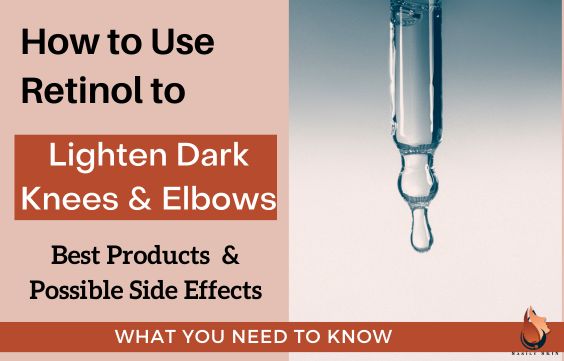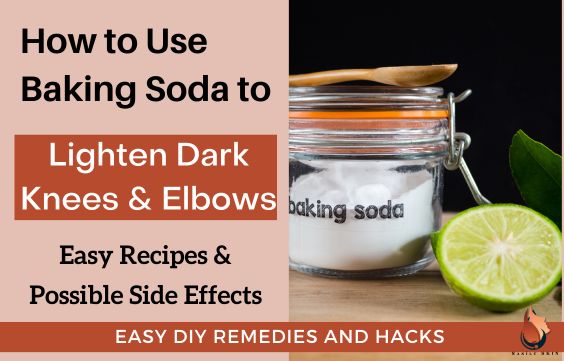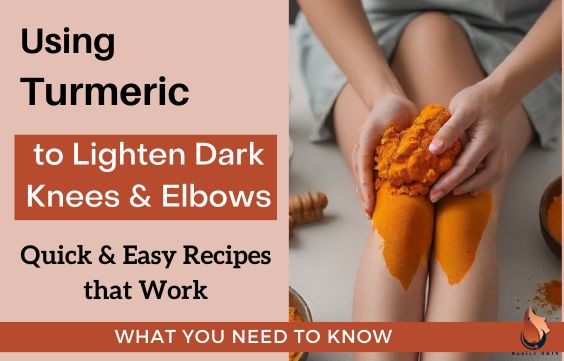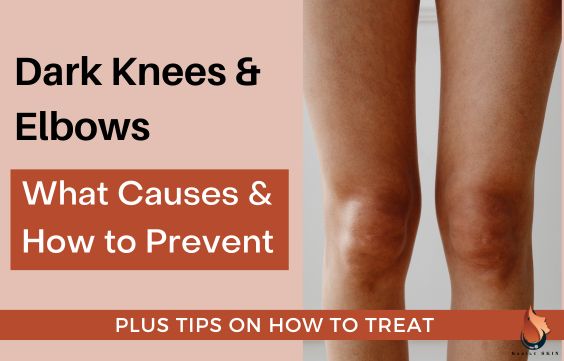9 Best Medical Ways to Lighten Dark Knees & Elbows
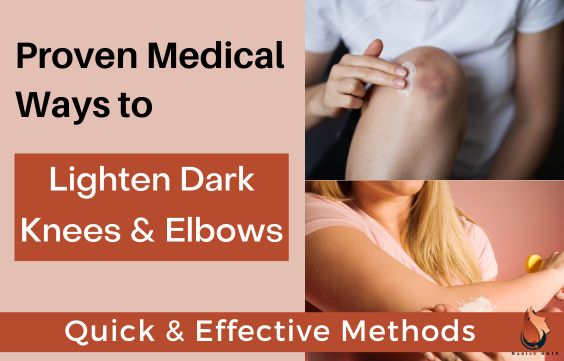
Medical ways to lighten dark knees & elbows will refer to ingredients that treatments are done in a clinic and those that you can obtain over the counter to use at home.
We will look at ingredients and procedures that have been researched and are proven to reduce hyperpigmentation.
Ingredients To Lighten Dark Knees & Elbows
The ingredients listed here can mostly be obtained over the counter in a variety of forms and concentrations (serums, creams, soaps, etc).
If you are new to this kind of skincare or these ingredients, then I recommend that you consult a skin care professional on how best to use them on your skin.
I will provide you with the most important things you need to know about each in this article, but whether they will be right for your skin will depend on several factors like your skin’s sensitivity, how bad your hyperpigmentation is, any allergies, how you plan to use them, cost-effectiveness, etc.
1- Hydroquinone
Of all the ingredients I have in this article, hydroquinone is the only one that you cannot buy over the counter as regulated by the FDA. For you to purchase Hydroquinone, you will need it to be prescribed by a dermatologist.
And even so, the only FDA-approved hydroquinone product is Tri-Luma. So, if you see your doctor, this is the only hydroquinone product they are legally authorized to prescribe to you.
Now, hydroquinone is considered the gold standard for the treatment of hyperpigmentation. It works by inhibiting melanin synthesis by preventing the tyrosinase enzyme from working. In melanin-producing cells, it inhibits DNA synthesis and causes changes in the production of these cells.
According to research, hydroquinone is most effective in concentrations of 2%-4%. You should start with the lowest concentration and gradually work your way up if necessary. However, you should not use anything stronger than 4%.
Side effects of hydroquinone may include increased dryness (especially if you already have dry skin), itchiness, irritation, allergic or irritant contact dermatitis, redness, inflammation (swelling, pain or tenderness, redness, & warmth in and around the area), and/or stinging.
If your side effects are mild and bearable, please remember to inform your doctor as soon as you notice them so that they can advise you on whether you need to change or adjust your treatment to best benefit your skin. Moisturizing properly can also help. Click here to read more about How to Moisturize with Hydroquinone & The Best Ones To Use.
However, if the side effects are severe or unbearable, wash your skin and seek medical attention right away.
Also, avoid using Hydroquinone when pregnant or breastfeeding.
Related Articles:
A Guide to Using Hydroquinone for Dark Knees & Elbows
7 Best DIY Remedies For Dark Knees & Elbows
2- Vitamin C
Vitamin C is a widely available ingredient that also inhibits melanin production in the skin by affecting tyrosinase activity. It is also a powerful antioxidant and hydrator which helps strengthen and tighten the skin.
It can be bought over the counter in serums, creams, lotions, soaps, and even powders to add to DIY recipes. However, I recommend using Vitamin C serums. A little goes a long way, it’s easy to use, and it absorbs deeply into the skin.
Vitamin C, too, is available in different forms. According to researchers, the most bioavailable form (the form your body can make the most of the quickest) is L-ascorbic acid. Formulas that contain this form of Vitamin C usually come in colorless serums and in light-proof bottles or containers (dark and sealed so that light cannot penetrate them – light destabilizes and inactivates this form of Vitamin C). If your Vitamin C serum is yellow, it may have been destabilized.
The main side effect associated with Vitamin C is irritation. If you use a serum or formula that is too strong for your skin, it could irritate the skin. Most Vitamin C products will have about 10-15% Vitamin C. Start with a low concentration and gradually work your way up if needed.
My favorite Vitamin C serum that works and is great for sensitive skin is the TruSkin Vitamin C Serum. Click here to see it on Amazon.
Related Articles:
Best Scrubs & Exfoliators for Dark Knees & Elbows
5 Best Creams to Lighten Dark Knees & Elbows
Using Turmeric to Lighten Dark Knees & Elbows
3- Kojic Acid
Kjoic acid is made from different types of fungi. However, it works much in the same way as Vitamin C to lighten dark knees & elbows. It affects tyrosinase production and it has antioxidant properties. Its side effects may include irritation, contact dermatitis and in rare cases, allergic reactions.
It is most effective in concentrations of 1-4%. Keep in mind, though, that this is more intense than vitamin C and will penetrate the skin faster and deeper.
It works slower than hydroquinone but it is more aggressive than vitamin C. So, as usual, I recommend that you patch test your skin, start with a low concentration, and only gradually increase it if necessary.
Kojic acid can most often be found in soaps, serums and lotions, It is rarely used by itself and most often combined with ingredients like vitamin C or glycolic acid, both of which enhance its effects.
My favorite Kojic Acid products for dark knees & elbows (and hyperpigmentation in general) are:
- The Kojie San Soap and
- The Kojie San Lotion, you can click on the links to get them on Amazon.
4- Azelaic Acid
Azelaic acid is yet another ingredient that inhibits the enzyme tyrosinase. It is one of the most selective active lightening ingredients, which means that it works exclusively on hyperpigmentation, but not on parts of the skin where there is no hyperpigmentation.
It is most effective in treating melasma, post-inflammatory hyperpigmentation and lentigas (these are some of the most stubborn kinds of hyperpigmentation).
Experts recommend that azelaic acid be used in concentrations between 10-20%. And, on the plus side, it is one of the active lightening agents that shows the least side effects, except for mild, temporary redness.
A great azelaic acid formula that is great for your knees & elbows is the Naturium Azelaic Topical Acid 10%. You can Click here to see it on Amazon.
Related Articles:
Getting a Chemical Peel to Lighten Dark Knees & Elbows
What Causes Dark Knees & Elbows & How to Prevent
How to use Baking Soda to Lighten Dark Knees & Elbows
5- Arbutin
Arbutin is actually a derivative of hydroquinone, but it works less aggressively.
Very few clinical studies have been conducted regarding its skin-lightening effects, but what we do know is that it is one of the most widely prescribed skin-lightening and de-pigmenting agents worldwide; Arbutin also inhibits tyrosinase activity but in a dose-dependent manner.
However, although, higher concentrations may be more effective, a greater risk for paradoxical hyperpigmentation exists (this means it could cause the skin to darken more instead of lightening).
Arbutin is more suitable for mild hyperpigmentation. So if your knees and elbows are only a little darkened, this will be a great slow treatment.
A great serum I came across is the Minimalist 2% Alpha Arbutin Serum. Click here to see it on Amazon.
6- Glycolic Acid
Now, glycolic acid is not only a chemical exfoliant as previously thought, but studies have shown that it also inhibits melanin synthesis by affecting tyrosinase as well.
So not only does it do a great job at gobbling up skin cells at the top of the skin, but it also stops hyperpigmentation at the source. This makes it quite effective at treating stubborn dark patches like melasma and hyperpigmentation.
Click here to read more about Moisturizing After Glycolic Acid: What You Should Know
It is great for places like your knees and elbows which also need help with texture. It is best applied on the skin daily or a few times a week as a toner and in concentrations of 5-10%. Anything stronger should be discussed with a professional as it may make your skin peel. Glycolic acid peels are also an option (which we will discuss below).
My favorite glycolic acid toner for sensitive skin is the Pixi Glow Beauty Tonic. You can Click here to see it on Amazon.
And of course, the most popular one, which really works for stubborn dark patches if you have resilient skin and a good routine, is The Ordinary Glycolic Acid Toner.
Related Article – How to Use Glycolic Acid to Lighten Dark Elbows & Knees
7- Retinol
Retinol is an ingredient that will not affect melanin production itself, but rather, it will resurface the skin. It is a gradual treatment that will work slower than the more direct approach.
This is best for people who have mild to moderate hyperpigmentation and skin that is not sensitive. It does have side effects like irritation, but it will also help greatly with the texture and firmness of the skin.
Click here to read more about How to Use Retinol to Lighten Dark Knees & Elbows.
Procedures To Lighten Dark Knees & Elbows
If topical treatments are not working for your dark knees & elbows, there are a few procedures that can be done.
Both chemical peels and laser therapy are a bit more intense but also much more effective. However, these treatments should be done by skincare professionals and/or doctors after a proper consultation.
8- Chemical Peels
Chemical peels can significantly diminish discolored areas of skin, especially at high concentrations, by;
- Eliminating damaged cells.
- Increasing skin cell turnover, replacing them with healthy, normal cells.
- Preparing the skin to receive topical applications like azelaic acid which can help reduce discolouration even more.
- Disrupting melanin synthesis by suppressing tyrosinase activity
Generally, the best chemical peels to treat hyperpigmentation are:
- Glycolic acid Peels- Tend to be milder & better for sensitive skin
- Lactic Acid Peels
- Salicylic Acid Peels
- Trichloroacetic Acid (TCA) Peels (Most effective but harsher on your skin)
Click here to read all about the different kinds of Chemical Peel For Hyperpigmentation: Ultimate Guide.
You can also check out my articles What to Expect After a Chemical Peel & When Do You Recover.
Chemical Peel AfterCare Tips To Heal Fast & Common FAQ to learn more.
9- Laser Therapy
Laser therapy is a great way to lighten specific areas of stubborn hyperpigmentation like your knees & elbows.
LASER is an acronym for Light Amplification by the Stimulated Emission of Radiation.
Lasers are sources of high-intensity light. Based on the kind of light being used, they can be focused on small or specific areas of skin with very high energy. The melanated (dark) cells absorb the light, which heats them internally and destroys them.
This technique also helps to prevent too much damage to the surrounding cells, keeping the destruction within the pigmented area.
Laser therapy has to be done in a clinic by a professional. It can be quite expensive but it is very effective.
Click here to read about Laser Treatment For Dark Inner Thighs – What to Know and Laser Whitening for Underarms: Cost, Risks, How Fast Is it
The process, effects and results will be almost the same. Costing will differ based on how many sessions you need.
Sources
Vitamin C in dermatology – PMC
Cosmeceuticals for Hyperpigmentation: What is Available? – PMC
Lasers for Treatment of Melasma and Post-Inflammatory Hyperpigmentation – PMC
The inhibitory effect of glycolic acid and lactic acid on melanin synthesis in melanoma cells


